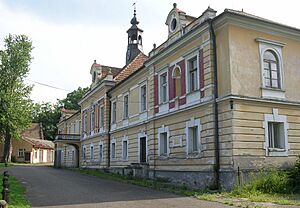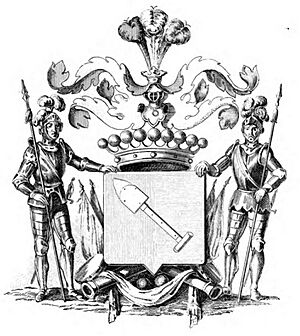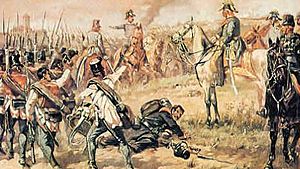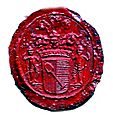Joseph Radetzky von Radetz facts for kids
Quick facts for kids
Joseph Radetzky von Radetz
|
|
|---|---|
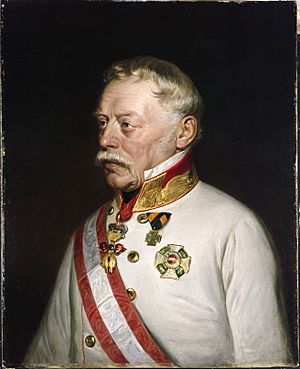
Portrait by Georg Decker
|
|
| Born | 2 November 1766 Třebnice, Kingdom of Bohemia, Holy Roman Empire (today Czech Republic) |
| Died | 5 January 1858 (aged 91) Milan, Kingdom of Lombardy-Venetia, Austrian Empire (today Italy) |
| Allegiance | |
| Years of service | 1785–1858 |
| Rank | Field Marshal |
| Battles/wars | Austro-Turkish War French Revolutionary Wars Napoleonic Wars First Italian War of Independence |
Joseph Radetzky von Radetz (born November 2, 1766 – died January 5, 1858) was a famous Field Marshal from Bohemia who served the Austrian Empire. He was known for being a very disciplined and fair leader. His soldiers loved him so much they called him Vater (which means 'Father') Radetzky.
He is most famous for his important victories in Italy. These include the Battle of Custoza in 1848 and the Battle of Novara in 1849. These battles were part of the First Italian War of Independence.
Contents
Early Life and Military Start
Joseph Radetzky was born into a noble family in Bohemia, which is now part of the Czech Republic. He was born at Chateau Třebnice near Sedlčany. Sadly, he became an orphan when he was very young. His grandfather raised him, and after his grandfather passed away, Joseph went to the Theresa Academy in Vienna.
In 1785, he joined the Austrian Army as a cadet. The next year, he became an officer. By 1787, he was a first lieutenant. He served as an assistant to important generals during the Austro-Turkish War (1787–1791).
In 1798, he married Countess Francesca von Strassoldo Grafenberg. They had five sons and three daughters. Only two of their children lived longer than their father. Radetzky was a devoted Roman Catholic.
Fighting in the Napoleonic Wars
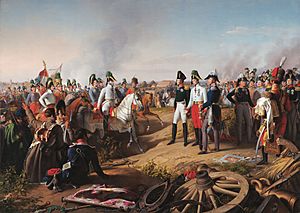
In 1796, Radetzky fought against Napoleon in Italy. He was known for his bravery. For example, at the Battle of Valeggio sul Mincio in 1796, he bravely rescued his general from the enemy with just a few soldiers. He was promoted to major and later to lieutenant-colonel and colonel. He showed great skill in battles like Trebbia and Novi in 1799.
During the Battle of Marengo, he was hit by five bullets but survived. In 1801, he received the Military Order of Maria Theresa, a very high honor.
In 1805, he became a major-general and fought in Italy. He spent the peace times studying and teaching about warfare. In 1809, he led a brigade at the Battle of Eckmühl. He was promoted again to lieutenant field marshal and commanded a division at the Battle of Wagram.
From 1809 to 1812, he worked to reorganize the Austrian army. He wanted to make it stronger and more modern. However, he faced problems with funding and eventually resigned from this role.
In 1813, he became the chief of staff for Prince Schwarzenberg, who led the Allied armies against Napoleon. Radetzky played a big part in planning the important Leipzig campaign. He was praised for his smart tactics in battles like Brienne and Arcis-sur-Aube. He entered Paris with the Allied leaders in March 1814. He also attended the Congress of Vienna, where he helped with important discussions.
Campaigns in Italy
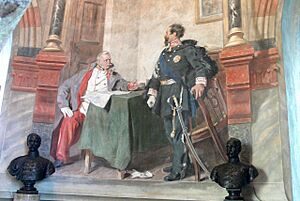
After the Napoleonic Wars, Radetzky continued to work on improving the army. However, his ideas were often ignored by the government. In 1829, it was even suggested that he retire. But the emperor decided to promote him to general of cavalry instead.
Soon, Europe faced new problems, and Radetzky was called back to action. He took command of the Austrian army in Italy in 1834.
In 1836, Radetzky became a full Field Marshal. He was seventy years old but still had the energy of a young man. He worked hard to train and discipline his army.
In 1848, there were many uprisings in Italy. Radetzky and his army faced tough challenges against the Sardinian army and rebels in cities like Milan. He cleverly moved his troops to a strong defensive area called the Quadrilatero. This allowed him to hold off his enemies until more Austrian soldiers arrived.
After getting reinforcements, Radetzky led his army to victory. His most famous win was at the Battle of Novara on March 23, 1849. He also led the troops who took back Venice after a long siege. In 1848, he received another high honor, becoming a Knight of the Order of the Golden Fleece.
After his great success in Italy, Radetzky was made Viceroy of Lombardy-Venetia from 1848 to 1857. He was the only person not from the royal Habsburg family to hold this position. During his time as Viceroy, he ruled with a firm hand to prevent further rebellions.
Death and Burial
Joseph Radetzky von Radetz died from pneumonia on January 5, 1858, in Milan. The Emperor wanted him to be buried in the Imperial Crypt in Vienna. However, Radetzky had arranged to be buried by a man named Joseph Gottfried Pargfrieder, who had helped him with his debts years before.
On January 19, 1858, Radetzky was buried at the Heldenberg Memorial in Lower Austria. This is a special place with statues celebrating Austrian military heroes. Radetzky is buried in a crypt under a large obelisk, along with another field marshal and Pargfrieder himself.
Legacy
Radetzky is remembered as a brilliant military leader. He was known for his tactical skills and for keeping his army loyal during difficult times. His strong leadership helped the Austrian Empire maintain control in Italy for a while.
Honours and Awards
Radetzky received many important awards and decorations from different countries for his military service. Some of the most notable include:
- From the Austrian Empire:
* Knight of the Military Order of Maria Theresa * Knight of the Order of the Golden Fleece * Grand Cross of St. Stephen
- From the Russian Empire:
* Knight of St. George * Knight of St. Andrew
- From Prussia:
* Knight of the Order of the Black Eagle
- From Denmark:
* Knight of the Order of the Elephant
Images for kids
See also
 In Spanish: Joseph Radetzky para niños
In Spanish: Joseph Radetzky para niños


